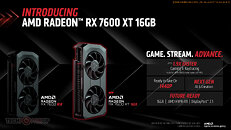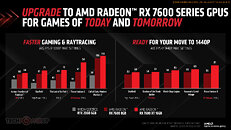- Joined
- Oct 9, 2007
- Messages
- 47,617 (7.44/day)
- Location
- Dublin, Ireland
| System Name | RBMK-1000 |
|---|---|
| Processor | AMD Ryzen 7 5700G |
| Motherboard | Gigabyte B550 AORUS Elite V2 |
| Cooling | DeepCool Gammax L240 V2 |
| Memory | 2x 16GB DDR4-3200 |
| Video Card(s) | Galax RTX 4070 Ti EX |
| Storage | Samsung 990 1TB |
| Display(s) | BenQ 1440p 60 Hz 27-inch |
| Case | Corsair Carbide 100R |
| Audio Device(s) | ASUS SupremeFX S1220A |
| Power Supply | Cooler Master MWE Gold 650W |
| Mouse | ASUS ROG Strix Impact |
| Keyboard | Gamdias Hermes E2 |
| Software | Windows 11 Pro |
AMD announced the new Radeon RX 7600 XT graphics card, bolstering its mid-range of 1080p class GPUs. The RX 7600 XT is designed for maxed out AAA gaming at 1080p, although it is very much possibly to play many of the titles at 1440p with fairly high settings. You can also take advantage of technologies such as FSR 3 frame generation in games that support it, AMD Fluid Motion Frames on nearly all DirectX 12 and DirectX 11 games; as well as the new expanded AMD HyperRX performance enhancement that engages a host of AMD innovations such as Radeon Super Resolution, Anti-Lag, and Radeon Boost, to achieve a target frame rate.
The Radeon RX 7600 XT is based on the same 6 nm "Navi 33" silicon, and the latest RDNA 3 graphics architecture, as the Radeon RX 7600. If you recall, the RX 7600 had maxed out all 32 CU on the silicon. To design the RX 7600 XT, AMD retained the "Navi 33," but doubled the memory size to 16 GB, and increased the clock speeds. The 16 GB of memory is deployed across the same 128-bit wide memory bus as the 8 GB is on the RX 7600. The memory speed is unchanged, too, at 18 Gbps GDDR6-effective; as is the resulting memory bandwidth, of 288 GB/s. There are two key changes—the GPU clock speeds and power limits.




The Game Clock of the RX 7600 XT is set at 2.47 GHz, compared to 2.25 GHz on the RX 7600; and the maximum Boost Clock is set at 2.76 GHz, compared to 2.66 GHz on the RX 7600. To support these, and improve boost clock residency, AMD increased the total board power (TBP) to 190 W, up from 165 W on the RX 7600. As a result, the RX 7600 XT custom-design graphics cards will feature two 8-pin PCIe power connectors, or at least a combination of 6-pin and 8-pin; while the RX 7600 made to with just one 8-pin.
Another small change with the RX 7600 XT is that board partners will be mandated to wire out DisplayPort 2.1 on their custom boards (to use the required clock drivers and other ancillaries); they cannot opt to have DisplayPort 1.4 to save costs.
The 6 nm "Navi 33" silicon physically features 32 RDNA 3 compute units (CU), adding up to 2,048 stream processors, 64 AI accelerators, 32 Ray accelerators, 128 TMUs, and 64 ROPs. A 32 MB Infinity Cache memory cushions the 128-bit GDDR6 memory interface, which on the RX 7600 XT drives 16 GB, running at 18 Gbps.




Thanks to the increase engine clocks, the RX 7600 XT is shown posting a proportionate increase in performance across popular titles at 1080p with maxed out settings, including ray tracing. The RX 7600 XT is shown posing a near doubling in performance over the GeForce RTX 2060 6 GB. The RX 7600 XT is also shown offering playable frame rates at 1440p with max settings (albeit without ray tracing). AMD is making the case for 16 GB with creator and generative AI applications, where the large video memory should come very handy.
AMD Radeon RX 7600 XT will be available on January 24, 2024. It is exclusively a partner-driven launch, there will be no reference design in the retail market. AMD set $329 as the baseline price for the RX 7600 XT, a $60 premium over the RX 7600.
View at TechPowerUp Main Site
The Radeon RX 7600 XT is based on the same 6 nm "Navi 33" silicon, and the latest RDNA 3 graphics architecture, as the Radeon RX 7600. If you recall, the RX 7600 had maxed out all 32 CU on the silicon. To design the RX 7600 XT, AMD retained the "Navi 33," but doubled the memory size to 16 GB, and increased the clock speeds. The 16 GB of memory is deployed across the same 128-bit wide memory bus as the 8 GB is on the RX 7600. The memory speed is unchanged, too, at 18 Gbps GDDR6-effective; as is the resulting memory bandwidth, of 288 GB/s. There are two key changes—the GPU clock speeds and power limits.




The Game Clock of the RX 7600 XT is set at 2.47 GHz, compared to 2.25 GHz on the RX 7600; and the maximum Boost Clock is set at 2.76 GHz, compared to 2.66 GHz on the RX 7600. To support these, and improve boost clock residency, AMD increased the total board power (TBP) to 190 W, up from 165 W on the RX 7600. As a result, the RX 7600 XT custom-design graphics cards will feature two 8-pin PCIe power connectors, or at least a combination of 6-pin and 8-pin; while the RX 7600 made to with just one 8-pin.
Another small change with the RX 7600 XT is that board partners will be mandated to wire out DisplayPort 2.1 on their custom boards (to use the required clock drivers and other ancillaries); they cannot opt to have DisplayPort 1.4 to save costs.
The 6 nm "Navi 33" silicon physically features 32 RDNA 3 compute units (CU), adding up to 2,048 stream processors, 64 AI accelerators, 32 Ray accelerators, 128 TMUs, and 64 ROPs. A 32 MB Infinity Cache memory cushions the 128-bit GDDR6 memory interface, which on the RX 7600 XT drives 16 GB, running at 18 Gbps.




Thanks to the increase engine clocks, the RX 7600 XT is shown posting a proportionate increase in performance across popular titles at 1080p with maxed out settings, including ray tracing. The RX 7600 XT is shown posing a near doubling in performance over the GeForce RTX 2060 6 GB. The RX 7600 XT is also shown offering playable frame rates at 1440p with max settings (albeit without ray tracing). AMD is making the case for 16 GB with creator and generative AI applications, where the large video memory should come very handy.
AMD Radeon RX 7600 XT will be available on January 24, 2024. It is exclusively a partner-driven launch, there will be no reference design in the retail market. AMD set $329 as the baseline price for the RX 7600 XT, a $60 premium over the RX 7600.
View at TechPowerUp Main Site





